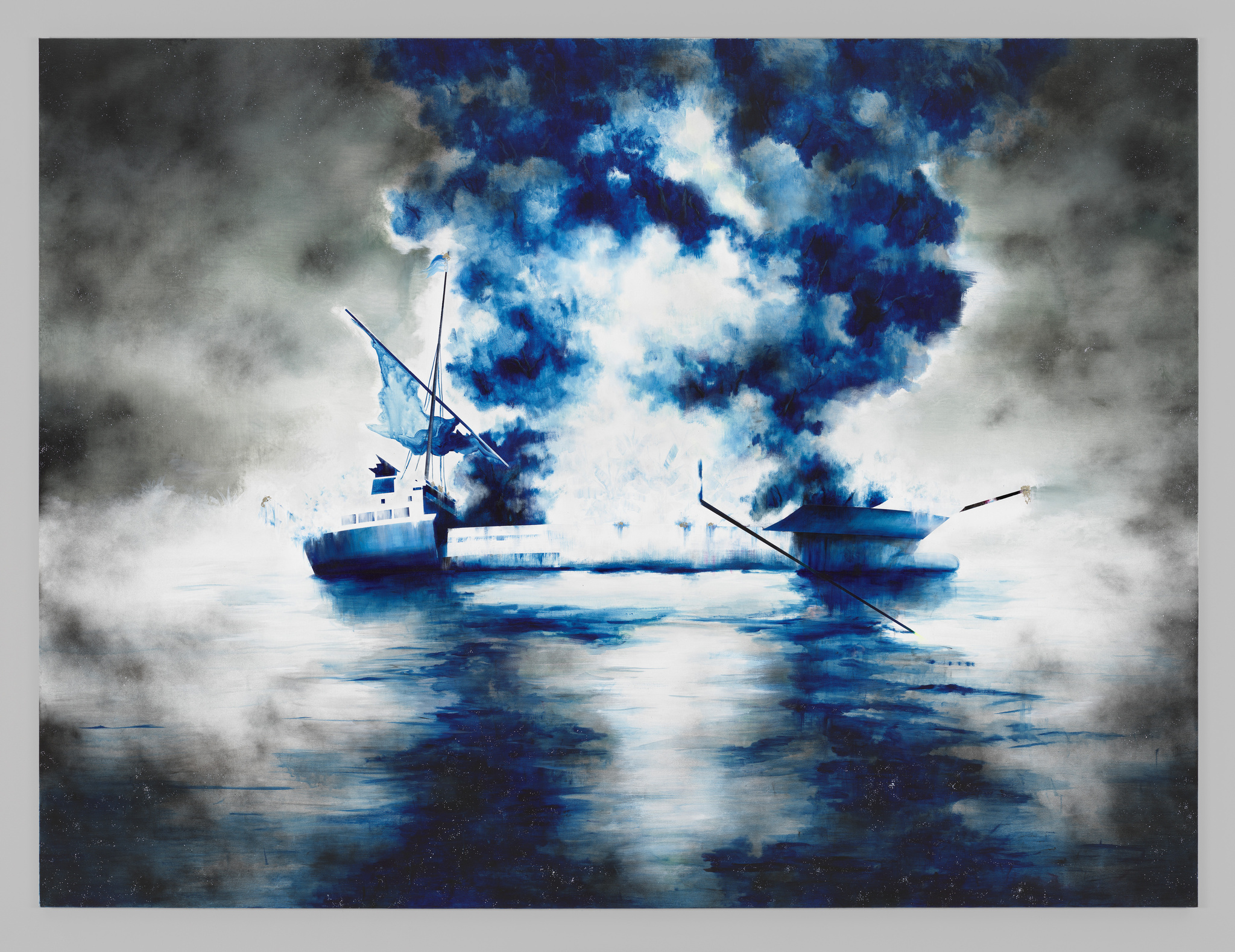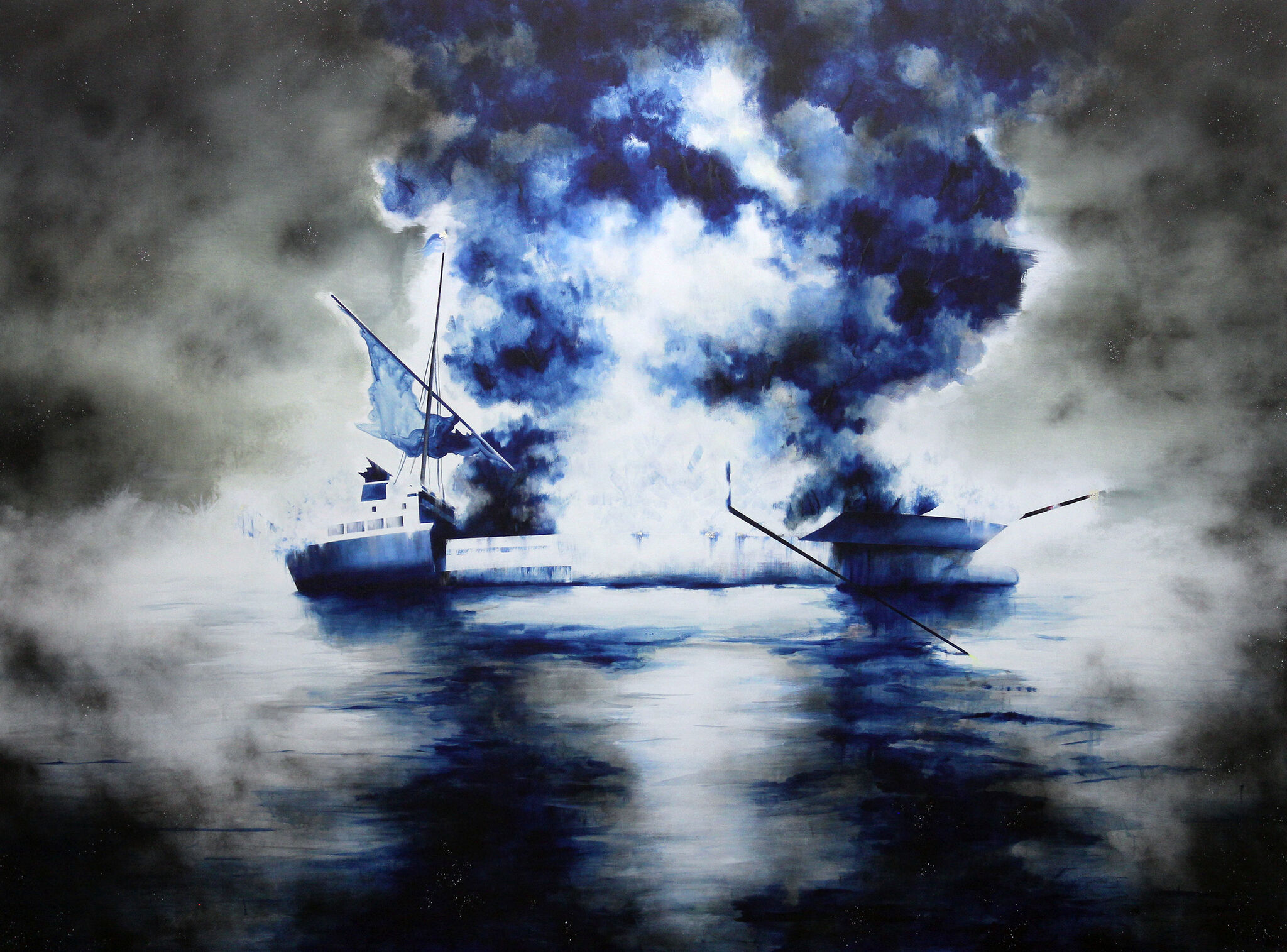Not on view
Date
2020–2021
Classification
Paintings
Medium
Ink and acrylic on canvas
Dimensions
Overall: 84 × 112 1/4in. (213.4 × 285.1 cm)
Accession number
2023.16
Credit line
Whitney Museum of American Art, New York; purchase, with funds from the Painting and Sculpture Committee
Rights and reproductions
© Gamaliel Rodríguez
Visual description
Collapsed Soul is a horizontal ink and acrylic painting on a canvas that is 7 feet tall by 9.3 feet wide. The focal point is an exploding ship in the center of the painting. The use of color is striking. The bottom of the image shows dark black and blue water contrasted by bright white light reflections on the surface. The ship is a deep royal blue and faces towards the left with four windows, a tall mast and billowing sail. Two black straight lines extend from the middle into the water and from the back of the ship through the smoke, perhaps leading to an anchor.
Smoke arises from the middle of the ship depicted in white at the center of the cloud and surrounded by splotches of blue. The shifts from white to light blue to royal blue and navy allow us to linger on the scene and the materiality of the medium. A halo of white around the smoke cloud and ship makes it pop and seem to glow.
Black and gray gradations frame the scene and cover the sky and the entire border of the image with a soft smokey texture. This also gives the image a vignette photography effect which distorts the sense of time. Rodríguez explains, “I wanted to create one more image, as if it was between past and future, as if they were images of the 18th century.”
Audio
-
Descripción verbal: Gamaliel Rodríguez, Alma colapsada, 2020–21
In no existe un mundo poshuracán: Puerto Rican Art in the Wake of Hurricane Maria (Spanish)
0:00
Descripción verbal: Gamaliel Rodríguez, Alma colapsada, 2020–21
0:00
Narrador: Collapsed Soul es una pintura horizontal en tinta y acrílico sobre un lienzo de 2,1 metros de alto por 2,8 metros de ancho. El punto focal es un barco en plena explosión en el centro de la pintura. El uso del color resulta muy llamativo. En la parte inferior de la imagen se observa un agua de color negro y azul oscuro que contrasta con los reflejos de luz blanca brillante en la superficie. El barco es de un azul eléctrico intenso y está orientado hacia la izquierda; tiene cuatro ventanas, un mástil alto y una vela ondulante. Dos líneas rectas negras se extienden desde la parte trasera del barco hacia el humo y desde el centro hacia el agua, quizás desembocando en un ancla.
Del medio del barco emerge una nube de humo representada de color blanco en el centro y rodeada de manchas azules. La transición entre los colores blanco, azul claro, azul eléctrico y azul marino nos permite sumergirnos en la escena y en la materialidad del medio. Alrededor de la nube de humo y del barco hay un halo blanco que hace que se destaque y parezca brillar.
La escena se enmarca en gradaciones de negro y gris, que cubren el cielo y todo el borde de la imagen con una suave textura ahumada. Esto también le da a la imagen un efecto de viñeta de fotografía que distorsiona el sentido del tiempo. Según explica Rodríguez: “Quería crear una imagen más, como si estuviera entre el pasado y el futuro, como si fueran imágenes del siglo XVIII”.
-
Verbal Description: Gamaliel Rodríguez, Collapsed Soul, 2020–21
In no existe un mundo poshuracán: Puerto Rican Art in the Wake of Hurricane Maria
0:00
Verbal Description: Gamaliel Rodríguez, Collapsed Soul, 2020–21
0:00
Narrator: Collapsed Soul is a horizontal ink and acrylic painting on a canvas that is 7 feet tall by 9.3 feet wide. The focal point is an exploding ship in the center of the painting. The use of color is striking. The bottom of the image shows dark black and blue water contrasted by bright white light reflections on the surface. The ship is a deep royal blue and faces towards the left with four windows, a tall mast and billowing sail. Two black straight lines extend from the middle into the water and from the back of the ship through the smoke, perhaps leading to an anchor.
Smoke arises from the middle of the ship depicted in white at the center of the cloud and surrounded by splotches of blue. The shifts from white to light blue to royal blue and navy allow us to linger on the scene and the materiality of the medium. A halo of white around the smoke cloud and ship makes it pop and seem to glow.
Black and gray gradations frame the scene and cover the sky and the entire border of the image with a soft smokey texture. This also gives the image a vignette photography effect which distorts the sense of time. Rodríguez explains, “I wanted to create one more image, as if it was between past and future, as if they were images of the 18th century.”
-
Gamaliel Rodriguez, Alma colapsada, 2020–2021
In no existe un mundo poshuracán: Puerto Rican Art in the Wake of Hurricane Maria (Spanish)
0:00
Gamaliel Rodriguez, Alma colapsada, 2020–2021
0:00
Gamaliel Rodriguez: Hola, mi nombre es Gamaliel Rodríguez.
Narrador: Rodríguez tituló a esta pintura de gran formato Alma contraída.
Gamaliel Rodriguez: El barco siempre me ha fascinado. La travesía, los retos que enfrentan. Este en particular fue una cosa bien interesante. Yo en el 2015 hice una residencia artística en un lugar que se llama Long Road Project, en Jacksonville (para el 2015, eso fue mucho antes del huracán), yo estaba buscando el problema de Puerto Rico con la situación de la comida. Nosotros no estamos produciendo suficiente productos comestibles desde bananas, alimentos, vegetales, de todo. Entonces tenemos un problema grande de alimentación que tenemos que considerar para nuestro futuro. Si tú no vale. Puerto Rico producía antes del huracán María aproximadamente 15% de nuestro producto de comestibles. Ahora mismo, después del huracán María, solamente producimos un siete, o sea, 93% de nuestros comestibles vienen de aquí de Estados Unidos y el puerto principal, Jacksonville, este en particular allá. Yo me doy la tarea de entender el Life Line o la línea importante de navegación entre Jacksonville y Puerto Rico, porque nosotros recibimos prácticamente nuestro. Nuestra comida, nuestro sustento de Jacksonville. ¿Qué sucede? En el 2015, hubo un desastre donde el barco El Faro se hunde el 1 de octubre de 2015 porque fue devastado por el huracán Joaquín. Ellos zarpan en el 29 de septiembre desde Jacksonville con comestibles, lo que se llamaba lo que se conoce un cargo ships que se le conoce como roll-on roll-off o lift-on lift-off es son barcos que son específicos para traer desde comida, madera, clavos, tornillo, vehículos pesados. Vehículos livianos, de todo. Ese barco es prácticamente, es como un Costco, o un Walmart o un Home Depot ambulante. Es el que te lleva todo. Y nosotros vivimos en una isla, es totalmente aislado. Y si no tienes esos productos, no vas a poder comer.
Así que cuando yo analizo lo más impresionante del barco que se construyó en 1975 es que originalmente se llamaba Puerto Rico, y es bien interesante como el barco en muchas formas tiene una muy buena conexión bien grande con Puerto Rico. Primero, Puerto Rico parece un barco que está en medio de entre el Océano Atlántico y el Mar Caribe. Yo encuentro que está a la deriva, que lamentablemente no tenemos un capitán que pueda, o no han habido los capitanes, que se necesitan para poder llevar una una visión o un país de un punto A punto B. Igual que un barco, están en condiciones deplorables, igual que la corrupción que hay en Puerto Rico que ha destruido el país por los pasados 40 o 50 años.
Y dije Guau, Eso fue antes del huracán María. Cuando pasó el huracán María, fue todo tres o cuatro veces peor de lo que nunca nos imaginamos que iba a pasar.
-
Gamaliel Rodriguez, Collapsed Soul, 2020–2021
In no existe un mundo poshuracán: Puerto Rican Art in the Wake of Hurricane Maria
0:00
Gamaliel Rodriguez, Collapsed Soul, 2020–2021
0:00
Gamaliel Rodríguez: Hi, my name is Gamaliel Rodríguez.
Narrator: Rodríguez titled this large painting Collapsed Soul.
Gamaliel Rodríguez: I have always been fascinated by ships. The voyage, the challenges they face. That in particular was a very interesting thing. In 2015, I did an artist residency called the Long Road Projects in Jacksonville (2015 was some time before the hurricane), and I was looking into Puerto Rico’s problems with the food situation. We are not producing enough food, whether it’s bananas, vegetables, all types of food. So, we have a big problem with nutrition, which we have to think about for our future. Puerto Rico used to produce approximately fifteen percent of its food before Hurricane Maria. Right now, since Hurricane Maria, we only produce seven percent. That is, ninety-three percent of our food comes from here in the United States, with the main port being Jacksonville. What happened? In 2015, there was a disaster when the ship El Faro sank on October 1, 2015, after being destroyed by Hurricane Joaquin. They sailed from Jacksonville on September 29 with foodstuffs, it was called a—what is known as a roll-on/roll-off or lift-on/lift-off cargo ship. They’re ships specifically for carrying anything from food, lumber, nails, everything. The ship is basically a traveling Costco or Walmart or Home Depot. And we live on an island, which is completely isolated. If you don’t have those products, you’re not going to be able to eat.
So, when I analyze it, the most impressive thing about the ship, built in 1975, is that it was originally called the Puerto Rico, and it’s really interesting how a ship in many ways has a very close—a very big connection to Puerto Rico. First, Puerto Rico is like a ship in the middle, between the Atlantic Ocean and the Caribbean. I see that it is adrift, that we sadly do not have a captain capable of, or that there haven’t been the captains we need to be able to have a vision or take a country from point A to point B. Just like a ship, they are in deplorable condition, like the corruption in Puerto Rico that has destroyed the country for the past forty or fifty years.
And that was before Hurricane Maria. After Hurricane Maria, things were three or four times worse than we had ever imagined would happen.


